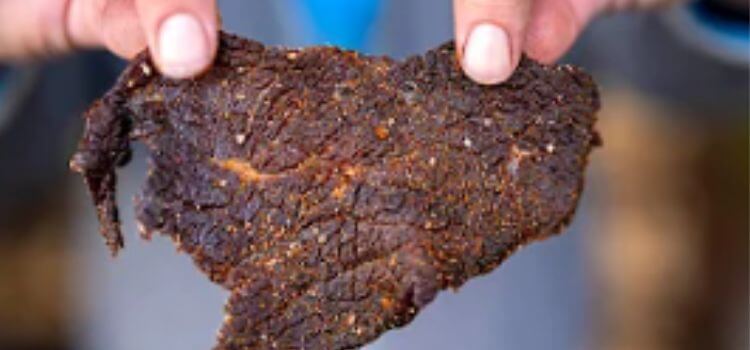As an Amazon Associate I earn from qualifying purchases.
Introduction
When it comes to dried meat snacks, two popular options that often come to mind are carne seca and beef jerky. These savory treats have captivated the taste buds of meat enthusiasts around the world. While they may seem similar at first glance, there are characteristics and differences that set them apart.

In this article, we will delve into the intricacies of carne seca vs beef jerky, exploring their origins, production methods, flavors, and textures. So, buckle up and get ready for a meaty adventure!
Carne Seca A Mexican Delicacy with Centuries of Tradition
Carne seca, which translates to “dry meat” in English, is a traditional Mexican delicacy that has been enjoyed for centuries. Native tribes in Mexico developed this method of preserving meat as a way to make it last longer. It involves marinating thin strips of meat, usually beef, in a flavorful mixture of spices and seasonings before drying it in the sun or using low heat to remove moisture. This time-honored process results in tender, flavorful, and shelf-stable meat that can be enjoyed for months.
The Art of Carne Seca Production
Carne seca production is an art form that requires precision and expertise. Here’s a glimpse into the process
Flavor Profile and Texture of Carne Seca
Carne seca boasts a rich, smoky, and robust flavor profile. The blend of spices used during the marination process infuses the meat with layers of complexity. It is common to find hints of chili, garlic, and cumin dancing on the taste buds with each bite.
In terms of texture, carne seca has a satisfying chewiness. The drying method removes most of the moisture, resulting in a jerky-like consistency that requires a bit of work to tear apart. However, it is not overly tough and provides a pleasant resistance as you savor each bite.
Beef Jerky. A Worldwide Phenomenon
Beef jerky, a globally recognized dried meat snack, has roots in various cultures around the world. The process of drying meat for preservation can be traced back thousands of years. Over time, different regions have developed their own unique variations of jerky, each with its own flavors and techniques.
The Art of Beef Jerky Pr oduction
While there are countless variations of beef jerky, the production process generally follows these steps
Flavor Profile and Texture of Beef Jerky
The flavor profile of beef jerky can vary widely depending on the marinade and additional seasonings used. From sweet and smoky to spicy and tangy, there is a jerky flavor to suit every palate. Popular seasoning options include teriyaki, black pepper, honey BBQ, and chili lime.
In terms of texture, beef jerky ranges from tender and moist to dry and chewy. own preferences play a significant role in the desired texture, with some people preferring a softer jerky that almost melts in the mouth, while others enjoy a tougher and more substantial chew.
Conclusion
Carne seca vs beef jerky may share the common characteristic of being dried meat snacks, but their differences are what make them unique. Carne seca, deeply rooted in Mexican tradition, offers a smoky and robust flavor profile with a satisfying chewiness. On the other hand, beef jerky showcases a diverse range of global variations, each with its own distinct flavors and textures. Whether you prefer the traditional flavors of carne seca or the global appeal of beef jerky, one thing is certain: these dried meat snacks are here to stay, delighting carnivores and snack enthusiasts alike.
So, the next time you’re craving a savory and protein-packed treat, consider indulging in the mouthwatering world of carne seca and beef jerky!
FAQs Common Questions About Carne Seca vs Beef Jerky
No, carne seca and beef jerky are not the same. While they are both dried meat snacks, they differ in their production methods, flavors, and cultural origins. Carne seca is a traditional Mexican delicacy, while beef jerky has global variations.
Yes, both carne seca and beef jerky can be made from meats other than beef. However, the term “beef” typically refers to the meat of cattle, whereas carne seca can include dried meat from various animals, such as pork, venison, or even turkey.
When properly stored in airtight containers, both carne seca and beef jerky have impressive shelf lives. They can last for several months, making them ideal for hiking trips, road trips, or emergency snacks.
Carne seca and beef jerky can be healthy snacks when consumed in moderation. They are high in protein and low in carbohydrates, making them a popular choice for individuals following high-protein or low-carb diets. However, it’s important to choose varieties with minimal additives or excessive sodium content.
Yes, there are vegetarian and vegan alternatives to carne seca and beef jerky. Manufacturers have developed innovative plant-based alternatives using ingredients like soy, mushrooms, or textured vegetable protein (TVP). These alternatives aim to replicate the flavors and textures of traditional meat jerky.
Absolutely! Making your own carne seca or beef jerky can be a fun and rewarding culinary project. It allows you to experiment with flavors, seasonings, and textures according to your preferences. However, ensure you follow proper food safety guidelines and dehydrate the meat thoroughly to prevent spoilage.
Amazon and the Amazon logo are trademarks of Amazon.com, Inc, or its affiliates.